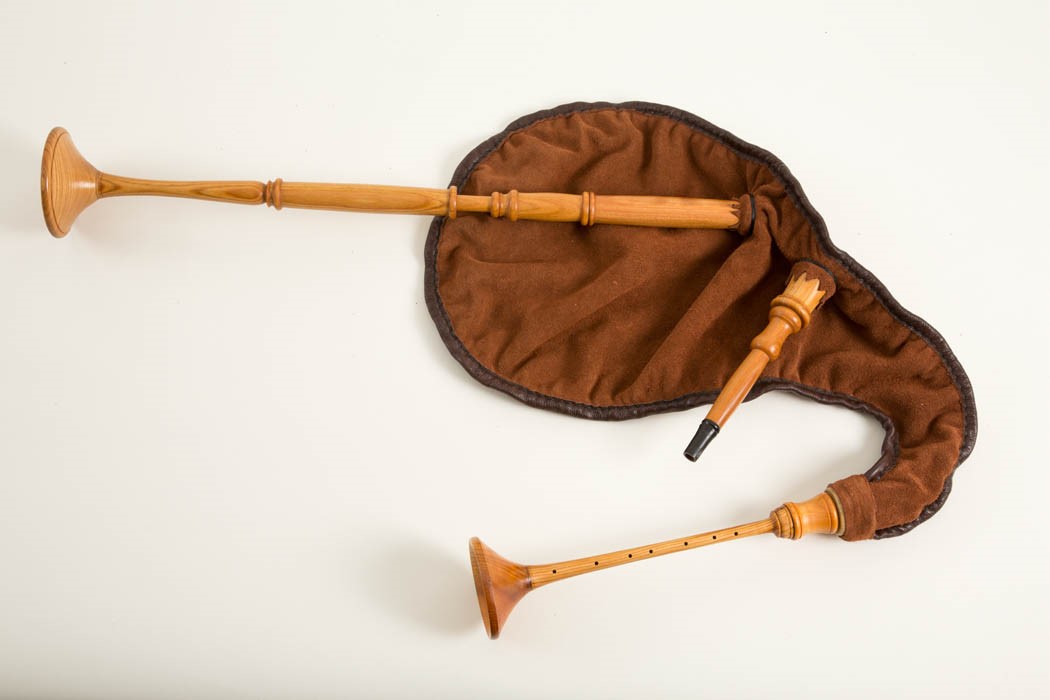A popular and versatile English bagpipe with a low, rich tone. It is simple enough for beginners but challenging enough for more experienced players.
The chanter and drone have large flared bells, a common feature in early illustrations and carvings of pipes in England. I arrived at my design with the help of my brother John, a musician and historian who has been researching the history of piping in the Midlands and Leicestershire in particular. It is a very compact instrument. A mouth-blown set weighs about one pound and with the drone dismounted its maximum length is fourteen inches.
I have been making the Leicestershire Smallpipe since the mid-1980s and it has proved to be an extremely popular pipe. It has a chanter with nine notes, a single drone an octave below the chanter’s key-note with a leather bag; it can be mouth-blown or bellows blown.

I make the standard mouth-blown D or C Leicestershire smallpipe in small batches and I often have one in stock or certainly available within a few months. They are made in cherry and yew and have the standard brown leather bag.
Non-standard woods, bag colours, tunings and other details can be incorporated as described below, available from my normal waiting-list, which is usually more than a year.
Chanters
The most popular key for these pipes is D. The chanter plays the notes of a D major scale and has a range of one octave plus a semitone. Compared with the bottom octave of the D penny whistle, it sounds an octave deeper (d’ in English Pitch Notation) and has a thumb hole to give the top D and a right-hand little finger hole to add the C# leading note below the bottom D. Chanters in other keys can be made; see below for details.

Reeds
The chanter has a slightly tapered bore and uses a plastic double reed of my own design. These reeds have a great tone and are very stable and trouble-free; some of my customers have been playing the same reed for 25 years or more.
The standard pipe has one drone, rich in harmonics, is tuned to D an octave below the chanter's key-note (ie. to d in English Pitch Notation). It has a plastic reed, and is made in two sections. If a C chanter is used the same drone can be tuned down to C; this arrangement proves very versatile in combination with the split-stock arrangement. Leaving the drone tuned to D offers other modal possibilities. To achieve the same effect with a D chanter, I can supply a D drone that will tune up to E.
Bag
The leather bag is hand-sewn and has a graceful swan neck that holds the chanter at the correct position for playing. The bellows-blown pipes are fitted with a velvet cover which is available in a variety of colours. The standard colour is brown; other colours are available on special order (some other bag colours can be seen in the Gallery bellow)
Bellows
The bellows are sturdily made of nailed leather with boards of cherry.

Fingering
Various possibilities are available for fingering the chanter. My preference is for what I refer to as ‘covered’ fingering; apart from the right-hand pinkie, only one finger is raised at any one time. My chanter is played with 'covered' fingering, i.e. only one finger is raised at any one time, apart from the right-hand pinkie, unlike the Northumbrian chanter, which is stopped at the end and uses ‘closed’ fingering, so that articulation between the notes is produced by the momentary silence when all the holes are covered. My chanter is open into its bell so that articulation is produced by returning briefly to the bottom D (on a D pipe) between each note, giving it a distinctive percussive character.
To help clarify this question I encourage you to watch this video. If required, the chanter can be supplied to play with other fingering systems, such as 'open' fingering; this has to be specified when ordering!
Watch the video about fingering systems
Split-stocks
The split-stock arrangement is standard on these pipes; it allows the interchange of chanters without fear of damaging the reeds.

detail of drone end
Keys
The use of split-stocks safely allows a versatility of drone/chanter combinations.
I have developed chanters in G, A, C, D, & F. Smallpipes with a drone that can be tuned to D or C can be played with a range of chanters; a D drone with G & D chanters, a C drone with C & F chanters.
I also make a larger smallpipe with a three-section drone tuneable to A or G which uses a low G chanter. I favour fitting these pipes with a bass drone tuneable to G or A and a tenor which can be tuned to D or C. With this drone arrangement and split stocks one can interchange chanters in D, A, G and C.

Flats, sharps and the tuning ring
This versatility can be further enhanced by the use of the ‘tuning ring’. This is fitted on the top hole to allow a semi-tone change in the pitch of the leading-note – on a D chanter this means the standard C sharp can be set to play C natural. I can also make chanters with ‘flat’ thirds and/or sixths. Please ask about these features.


